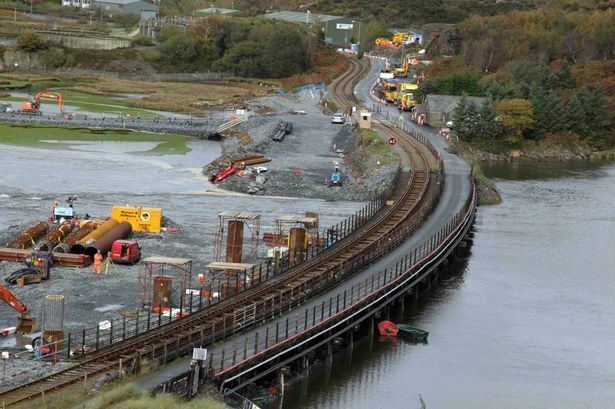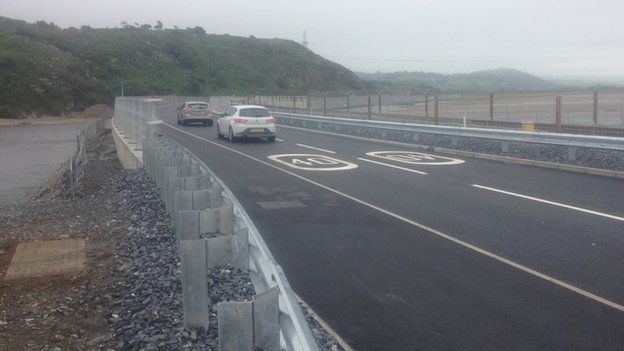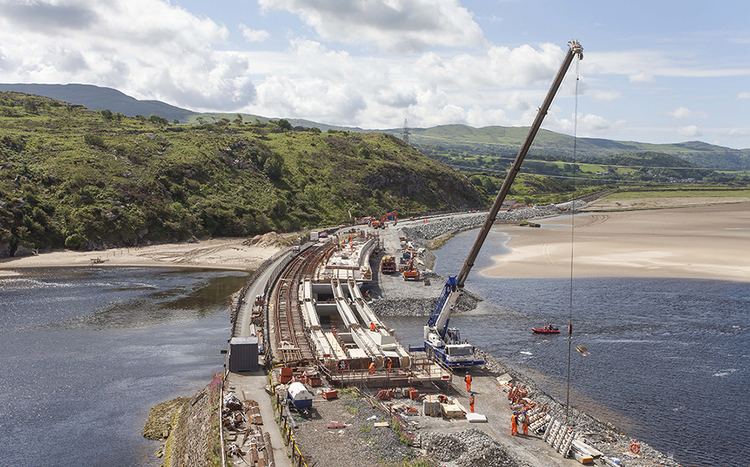Opened 1867 Material Wood Piers in water 21 | Owner Private Closed 2013 Carries Cambrian Line, A4085 road | |
 | ||
Width Standard gauge (4 foot 8½ inch) railway track10 feet (3.0 m) roadway Similar Llandecwyn railway station, Gwaith Powdwr, Machynlleth railway station, Pwllheli railway station, Barmouth Bridge | ||
Steam cambrian coast line wales uk pont briwet viaduct last ever steam train to cross it
Pont Briwet refers to the road and railway bridges that cross the River Dwyryd in Gwynedd, North Wales, connecting the town of Penrhyndeudraeth to the hamlet of Llandecwyn. The first bridge was a Victorian road and railway viaduct that was constructed entirely from timber. Although it was Grade II listed - as a rare example of a surviving 19th-century wooden road and railway viaduct, the structure was demolished in 2014 during a joint project between the Welsh government and Network Rail to upgrade the route.
Contents
- Steam cambrian coast line wales uk pont briwet viaduct last ever steam train to cross it
- Pont briwet short
- Victorian bridge
- Replacement
- References

The new Pont Briwet crosses the Dwyryd on the same alignment as the original structure but it is both stronger and wider to accommodate larger vehicles and traffic volume.

Pont briwet short
Victorian bridge

The Aberystwyth and Welsh Coast Railway was authorised in 1861 to build a line along Cardigan Bay between Aberystwyth and Porthdinllaen on the Lleyn Peninsula. Pont Briwet would carry the Cambrian Coast railway to Porthmadog. In 1865 the company merged with Cambrian Railways. However boardroom struggles within the newly created company led to a delay in the work. In February 1866 the bridge's contractor was declared bankrupt. Pont Briwet was not completed until the following year.

Pont Briwet stood on 21 piers; each pier comprised four or five timber piles that were braced with X-framed supports. These created a series of frames on which longitudinal beams carried the road and railway; beams under the rail tracks were substantially larger than those under the roadway. Although the bridge was decked with timber planks, the road carriageway was waterproofed with a metalled surface. Iron was used for bolts and bracing bars.

In 1932, the bridge was extensively rebuilt by GWR. Half the wooden piles were replaced with new creosoted pitch pine. Additional work also included changing the cross members and bracings. The work increased the overall width of the viaduct to 8.5 m (28 ft). Despite the nationalisation of the "Big Four" British railway companies in 1947, the viaduct remained a privately owned toll road for traffic between Penrhyndeudraeth and Harlech.

By 2010, a speed limit of 20 mph (32 km/h) had been imposed on trains crossing the bridge. Single-file traffic, which was controlled by signals at each end of the bridge, was restricted to vehicles under 2 t (2.2 tons). The weight restriction meant that the route was only passable by cars. This resulted in 8 miles (13 km) detours for heavier vehicles such as lorries or ambulances. Pedestrians were also unable to use the bridge because of the narrow width of the carriageway.
Replacement
In July 2010, the Welsh Assembly Government announced a £20 million joint project with Network Rail to replace the existing bridge with a new structure by 2013. The old bridge was to have been retained due to its listed structure and transformed into a pedestrian walkway. However once work began approval was granted for the viaduct's demolition in February 2012.
The new Pont Briwet would carry the single-track railway plus a two-lane carriageway and a 2.5 m (8 ft 2 in) cycle/walkway. The road's speed limit would be raised to 40 mph (64 km/h) and toll charges abolished. Although the road and rail bridges share the same pillars, like the original viaduct, the superstructures of the new crossings would be separate.
Planners also said that, apart from a four-week period when power cables had to be moved, the old viaduct would remain open throughout the works.
Work began in March 2013. However, in November 2013 the existing wooden bridge was found to have been affected by the piling work for the new bridge. It was declared structurally unsafe and closed in December 2013. This necessitated an 8-mile diversion via Maentwrog for road users and rail services were terminated at Harlech, closing the 22 miles (35 km) line to Pwllheli via Porthmadog. A new temporary road bridge was due to be in place by Spring 2014, but this plan was shelved by Gwynedd County Council in favour of a controlled traffic management system on the A496 between Maentwrog and Llandecwyn because of safety fears due to increased traffic on the A496.
The new rail viaduct opened for services between Harlech and Pwllheli on 1 September 2014. But work on the accompanying roadway was delayed by problems relocating the electricity cables and a water main that used the old bridge. After two years of work that incorporated significant delays, the road crossing opened to traffic in the summer of 2015.
